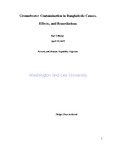Groundwater Contamination in Bangladesh: Causes, Effects, and Remediations

View/
Author
Telfeyan, Katherine C.
Subject
Washington and Lee University, Shepherd Poverty Program
Groundwater -- Pollution
Bangladesh
Water-supply
Arsenic -- Environmental aspects
Sedimentation and deposition
Water -- Purification -- Arsenic removal
Wells
Metadata
Show full item recordDescription
Capstone; [FULL-TEXT FREELY AVAILABLE ONLINE] Katherine C. Telfeyan is a member of the Class of 2010 of Washington and Lee University. Environmental scientist Dipankar Chakraborti captures the lack of understanding among the Bangladesh population to the severity and occurrence of arsenic contamination. Though arsenic patients are generally documented from 1983 onward, surveys indicate unusual occurrences of skin lesions from 1965. One man from Calcutta reports losing six of his nine affected family members as dying to cancer from arsenic related causes (Chakraborti et. al., 2002). The discovery of arsenic in groundwater has exacerbated the health problems and shortage of sanitary water in Bangladesh. Recent studies have discovered the extent and causes of poisoning, but the government has failed to take effective measures to mitigate this growing problem. This paper addresses the causes, occurrences, and effects of arsenic contamination as well as remediations for both removal and management. [From Introduction] Kat Telfeyan